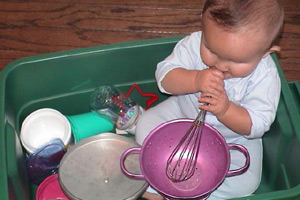Incidental Learning: What Is It?
This content is also available in:
Español (Spanish)
Did you know that educators believe more than 80 percent of what children learn comes to them through their vision? If you find that surprising, consider what happens when entering a room. At a glance, you’ll typically see and understand the room’s contents. Understanding who’s there, what they’re doing, and if there’s a window in the room, even what the weather is outside. Much of what children learn is acquired almost automatically and instantaneously—that is, incidentally. As they watch other children and adults interact with the environment and imitate their actions. Incidental learning is learning gained by observing people and activities around us, day by day.

If your baby has limited vision, they’ll need extra explanations, descriptions, and repeated experiences. This helps them to learn what other children learn simply by watching others and imitating them. It’s not a matter of your having to teach your child about things 24 hours a day, seven days a week. But you will want to keep in mind that your child won’t learn about the things they can’t touch. Even with things your baby can touch, your child may need more time to explore them. Maybe even some explanation from you to help truly understand what they are.
- Involve your baby in things you do around the house, even when they are very young. When it’s time to heat a bottle in the microwave, take your child with you, tell them what you’re doing, let them feel the cold air coming out of the refrigerator, carry the bottle with you, and let your child listen to the sound of the microwave. When the bottle is ready, with your hand under their hand, let your push the button to open the microwave door and touch the warm bottle. Otherwise, if you always bring the bottle to your child already heated, they’ll have no way of knowing how it gets that way.
- When you want to show your baby something, try to relate it to what they already know. For example, if you have a cat at home and your child likes to pet the cat and touch its legs and ears, relate the lion at the zoo to the cat. They both have fur, four legs, and ears. But lions are a lot bigger, don’t live with people as pets, and can be found in the zoo or in the wild.
Hands On Experiences
- When you show your baby an object, use the techniques called hand-under-hand. In hand-under-hand, your child’s hands are placed on top of yours, and they can feel your movements. It can be scary for your child to reach out and touch something when they can’t see what that something is and doesn’t know anything about it.
- Give your baby hands-on experiences. The more your child touches, the more they will learn. If your child loves to eat oranges, let them help pick them out at the grocery store, put them in the refrigerator when you get home, take one out when your child wants a snack, and help peel it. When your child drinks orange juice, explain that it’s made from the orange they like to eat. You might even have your child help you squeeze your own juice so they can really understand where the juice comes from.
- Look for places to take your child that have things for your child to touch. Petting zoos, science museums, and botanical gardens are often child-friendly and open to touching. If you do go to a place where touching isn’t part of the program, don’t be afraid to ask if your child may touch. If you have other children, make sure they too get a chance.